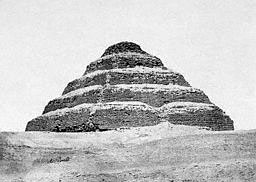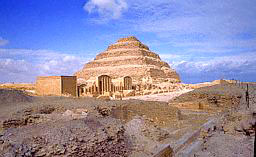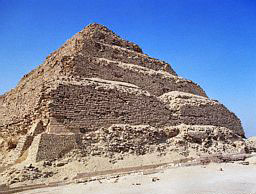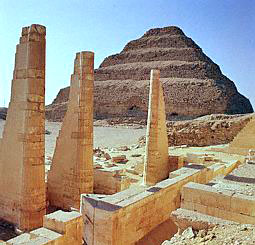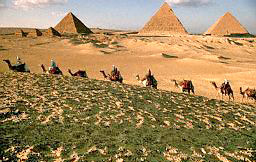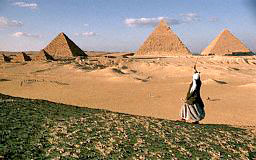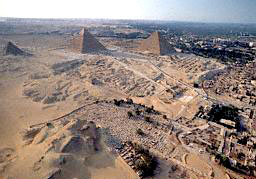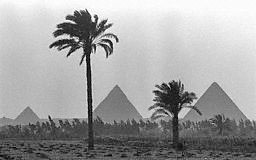|
Chapter Five
KEEPERS OF THE
SECRETS
"....The heavens bespeak the glory of the Lord and the vault of
heaven reveals His handiwork," the Psalmist wrote. The "heavens"
thus described were the nightly skies; and the glory they bespoke
was conveyed to Mankind by astronomer-priests. It was them who made
sense of the countless celestial bodies, recognized stars by their
groups; distinguished between the immovable stars and the wondering
planets, knew the Sunís and Moonís movements, and kept track of Time
- the cycle of sacred days and festivals, the calendar.
"The sacred days began at dusk of the previous evening - a custom
still retain in the Jewish calendar. A text which outlined the
duties of the Urigallu priest during the twelve day New Year
festival in Babylon throws light not only on the origin of priestly
rituals later on, but also on the close connection between celestial
observations and the festivalís proceedings. In the discovered text
(generally consider to reflect, as the priestís title URI.GALLU
itself, Sumerian origins) the beginning, dealing with the
determination of the first day of New Year (the first of the month
Nissan in Babylon) according to the spring equinox, is missing.
The inscription starts with the instructions for the second day:
On the second day of the month Nisannu,
two hours into the night,
the Urigallu priest shall arise
and wash with river water.
"Then, putting on a garment of pure white linen, he could enter into
the presence of the great god (Marduk in Babylon) and recite
prescribed prayers in the Holy of Holies of the ziggurat (the
Esagil
in Babylon). The recitation, which no one else was to hear, was
deemed so secret that after the text lines in which the prayer was
inscribed, the priestly scribe inserted the following admonition:
"Twenty-one lines: secrets of the
Esagil temple. Whoever reveres the
god Marduk shall show them to no one except the Urigallu priest."
"After he finished reciting the secret prayer, the
Urigallu priest
opened the templeís gate to let in the Eribbiti priests, who
proceeded to "perform their rites, in the traditional manner,"
joined by musicians and singers. The text then details the rest of
the duties of the Urigallu priest on that night.
""On the third day of the month
Nisannu" at a time after sunset too
damaged in the inscription to read, the Urigallu priest was again
required to perform certain rites and recitations.... until three
hours after sunrise," when he was to instruct artisans in the making
of images of metal and precious stones to be used in ceremonies on
the sixth day. On the fourth day, at "three and one third hours of
the night," the rituals repeated themselves but the prayers now
expanded to include a separate service for Mardukís spouse, the
goddess Sarpanit. The prayers then paid homage to the other
gods of
Heaven and Earth and asked for the granting of long life to the king
and prosperity to the people of Babylon. It was after that the
advent of the New Year was directly linked to the Time of the
Equinox in the constellation of the Ram Star at dawn. Pronouncing
the blessing "Iku-star" upon the "Esagil,
image of heaven and
earth," the rest of the day was spent in prayers, singing and music
playing. On that day, after sunset, the
Enuma Elish, the Epic of
Creation, was recited in its entirety.
"The fifth day of
Nissan was compared by Henri Frankfort (Kingship
and the Gods) to the Jewish Day of Atonement, for on that day the
king was escorted to the main chapel and was relieved there by the
High Priest of all the symbols of kingship; after which, struck in
the face by the priest and humiliated into prostrating himself, the
king pronounced declarations of confession and repentance....
"....the duties of the
Urigallu priest.... on that night at "four
hours of the night," recited twelve times the prayer "My Lord, is he
not my Lord" in honor of Marduk, and invoked the Sun, the Moon, and
the twelve constellations of the zodiac. A prayer to the goddess
followed, in which her epithet DAM.KI.ANNA ("Mistress of Earth and
Heaven" revealed the ritualís Sumerian origin. The prayer likened
her to the planet Venus "which shines brilliantly among the stars,"
naming seven constellations. After these prayers which stressed the
astronomical-calendrical aspects of the occasion, singers and
musicians performed "in the traditional manner" and a breakfast was
served to Marduk and Sarpanit "two hours after sunrise."
"The Babylonian New Year rituals evolved from the
Sumerian AKITI
("On Earth Build Life") whose roots can be traced to the state visit
by Anu and his spouse Antu circa 3800 B.C., when (as the texts
attest) the zodiac was ruled by the Bull of Heaven, the
Age of
Taurus. We have suggested that it was then that Counted Time, the
Calendar of Nippur, was granted to Mankind. Inevitably, that
entailed celestial observations and thus led to the creation of a
class of trained astronomers-priests.
"....Surprisingly, the
texts on the clay tablets (whose scribal
colophons identify them as copies of earlier originals) clearly
describe two sets of rituals - one taking place in the month Nissan
(the month of the spring equinox) and the other on the month
Tishrit
(the month of the autumnal equinox); the former was to become the
Babylonian and Assyrian New Year, and the latter was retained in the
Jewish calendar following the biblical commandment to celebrate the
New Year "in the seventh month," Tishrei. While the reason for this
diversity still mystifies scholars, Ebeling noted that the
Nissan
texts appear to have been better preserved than the Tishrei texts
which are mostly fragmented, suggesting a clear bias on the part of
the later temple scribes; and Falkenstein has noted that the
Nissan
and Tishrei rituals, seemingly identical, were not really so; the
former stressed the various celestial observations, the latter the
rituals within the Holy of Holies and its anteroom.
"Of the various texts, two main ones deal separately with
eve time
and sunrise rituals. The former, long and well preserved, is
especially legible from the point at which Anu and Antu, the divine
visitors from Nibiru, are seated in the courtyard of the sacred
precinct at eve time, ready to begin a lavish dinner banquet. As the
Sun was setting in the west, astronomer-priests stationed on various
stages of the main ziggurat were required to watch for the
appearance of the planets and to announce the sighting of the moment
the celestial bodies appeared, beginning with Nibiru....
"....As these compositions ("To the one who grows bright, the
heavenly planet of the Lord Anu" and "The Creatorís image has
arisen") were recited from the ziggurat, wine was served to the gods
from a golden libation vessel. Then, in succession, the priests
announced the appearance of Jupiter, Venus, Mercury,
Saturn, Mars, and the Moon. The ceremony of washing the hands followed, with water
poured from seven golden pitchers honoring the six luminaries of the
night plus the Sun of daytime. A large torch of "naphtha fire in
which spices were inserted" was lighted; all the priests sang the
hymn Kakkab Anu etellu shamame ("The planet of Anu rose in the
sky"), and the banquet could begin. Afterward Anu and Antu retired
for the night and leading gods were assigned as watchmen until dawn.
Then, "forty minutes after sunrise," Anu and Antu were awakened
"bringing to an end their overnight stay."
"The morning proceedings began outside the temple, in the courtyard
of the Bit Akitu ("House of the New Year Festival" in Akkadian).
Enlil and Enki were awaiting Anu at the "golden supporter," standing
by or holding several objects; the Akkadian terms, whose precise
meaning remains elusive, are best translated as "that which opens up
the secrets," "the Sun disks" (plural!) and "the splendid/shining
posts." Anu then came into the courtyard accompanied by gods in
procession. "He stepped up to the Great Throne in the Akitu
courtyard, and sat upon it facing the rising Sun." He was then
joined by Enlil, who sat on Anuís right, and Enki, who sat on his
left; Antu, Nannar/Sin, and Inanna/Ishtar then took places behind
the seated Anu.
"The statement that Anu seated himself "facing the rising Sun"
leaves no doubt that the ceremony involved a determination of a
moment connected with sunrise on a particular day - the first day of
Nissan (the spring Equinox Day) or the first day of
Tishrei (the
autumnal Equinox Day). It was only when this sunrise ceremony was
completed, that Anu was led by one of the gods and by the High
Priest to the BARAG.GAL - the "Holy of Holies" inside the temple.
"(BARAG means "inner sanctum, screened-off place" and
GAL means
"great, foremost." The term evolved to Baragu/Barakhu/Parakhu in
Akkadian with the meanings "inner sanctum, Holy of Holies" as well
as the screen which hides it. This term appears in the Bible as the
Hebrew word Parokhet, which was both the word for the Holy of Holies
in the temple and for the screen that separated it from the
anteroom. The traditions and rituals that began in Sumer were thus
carried on both physically and linguistically.)
"Another text from
Uruk,
instructing the priests regarding daily sacrifices, calls for the
sacrifice of "fat clean rams, whose horns and hooves are whole," to
the deities Anu and Antu, "to the planets
Jupiter, Venus, Mercury, Saturn and Mars; to the Sun as it rises, and to the
Moon on its
appearance." The text then explains what "appearance" means in
respect to each other of these seven celestial bodies: it meant the
moment when they come to rest in the instrument which is "in the
midst of the Bit Mahazzat" ("House of Viewing"). Further
instructions suggest that this enclosure was "on topmost stage of
the temple-tower of the god Anu."
"Depictions have been found that show divine beings flanking a
temple entrance and holding up poles to which ring-like objects are
attached. the celestial nature of the scene is indicated by the
inclusion of the symbols of the Sun and the Moon....
"....Other depictions of poles-with-rings freestanding, not held up,
flanking temple entrances suggest that they were the forerunners of
the uprights that flanked temples throughout the ancient Near East
in ensuing millennia, be it the two columns at Solomonís temple of
the Egyptian obelisks. That these originally had an actual and not
just symbolic astronomical function could be gathered from an
inscription by the Assyrian king Tiglatpileser I (1115-1077 B.C.) in
which he recorded the restoration of a temple to Anu and Adad that
was built 641 years earlier and that had been lying in ruins for the
past sixty years:
Two great towers
to discern the two great gods
I built in the House of Brilliance -
a place for their joy,
a place for their pride -
a brilliance of the stars of the heaven.
With the master-builderís artfulness,
with my own planning and exertions,
the insides of the temple I made splendid.
In its midst I made a place for the
rays directly from the heavens,
in the walls I made the stars to appear.
I made their brilliance great,
the towers I made to rise to the sky.
"According to this account, the two great towers of the temple were
not just architectural features, but served an astronomical purpose.
Walter Andrae, who led some of the most fruitful excavations in
Assyria, expressed the view that the serrated "crowns" that topped
towers that flanked temple gateways in Ashur, the Assyrian capital,
indeed served such a purpose (Die Jungeren Ishtar-Tempel). He found
confirmation for that conclusion in relevant illustrations on
Assyrian cylinder seals, that associate the towers with celestial
symbols. Andrae surmised that some of the depicted altars (usually
shown together with a priest performing rites) also served a
celestial (i.e., astronomical) purpose. In their serrated
superstructures these facilities, high up temple gateways or in the
open courtyards of temple precincts, created substitutes for the
rising stages of the ziggurats as the ziggurats gave way to the more
easily built flat-rooted temples.
"The Assyrian inscription also serves as a reminder that not only
the Sun at dawn, and the accompanying heliacal rising of stars and
planets, but also the nightly Host of Heaven were observed by the
astronomer-priests. A perfect example of such dual observations
concern the planet Venus, which because of its much shorter orbit
time around the Sun than Earthís appears to an observer from Earth
half the time as an evening star and half the time as a morning
star. A Sumerian hymn to Inanna/Ishtar, whose celestial counterpart
was the planet we call Venus, offered adoration to the planet first
as an evening star, then as a morning star....
"....After describing how both people and beasts retire for the
night "to their sleeping places" after the appearance of the Evening
Star, the hymn continues to offer adoration to Inanna/Venus as the
Morning Star....
"....While such texts throw light on the role of the
ziggurats and
their rising stages in the observation of the night sky, they also
raise the intriguing question: did the astronomer-priests observe
the heavens with the naked eye, or did they have instruments for
pinpointing the celestial moments of appearances? The answer is
provided by depictions of ziggurats on whose upper stages poles
topped by circular objects are emplaced; their celestial function is
indicated by the image of Venus or of the Moon.
"The hornlike devices (all graphics can be seen at
Mr. Sitchinís
books) serve as a link to Egyptian depictions of instruments for
astronomical observations associated with temples. There, viewing
devices consisting of a circular part emplaced in the center of a
pair of horns atop a high pole were depicted as raised in front of
temples to a god called Min. His festival, involved the erection of
a high mast by groups of men pulling cords - a predecessor, perhaps,
of the Maypole festival in Europe. Atop the mast are raised the
emblems of Min - the temple with the viewing lunar horns.
"The identity of
Min is somewhat of a mystery.... Min was also known
as Amsu or Khem, which according to E. A. Wallis Budge (The Gods of
the Egyptians) represented the Moon and meant "regeneration" - a
calendrical connotation.
|
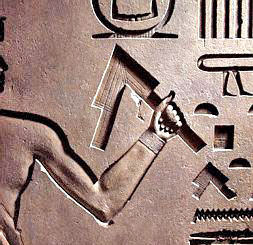
A detail of
Sesostris I dancing before the god Min showing him holding a
flail, signifying authority; Egyptian relief from Koptos.
|
"....Was Min perhaps
another incarnation of Thoth who was firmly linked to the lunar
calendar in Egypt? What is certain is that Min was deemed to be
related celestially to the Bull of Heaven, the zodiacal
constellation of Taurus, whose age lasted from about 4400 B.C. to
about 2100 B.C. The viewing devices that we have seen in the
Mesopotamian depictions and those associated with
Min in Egypt thus
represent some of the oldest astronomical instruments on Earth.
"According with the Uruk ritual texts, an instrument called
Itz
Pashshuri was used for the planetary observations. Thureau-Dangin
translated the term simply as "an apparatus"; but the term literally
meant an instrument "that solves, that unlocks secrets." Was this
instrument one and the same as the circular objects that topped
poles or posts, or was the term a generic one, meaning "astronomical
instrument" in general? We cannot be sure because both texts and
depictions have been found, from Sumerian times on, that attest to
the existence of a variety of such instruments.
"The simplest astronomical device was the gnomon (from the Greek
"that which knows"), an instrument which tracked the Sunís movements
by a shadow cast by an upright pole; the shadowís length (growing
smaller as the Sun rose to midday) indicated the hourly time and the
direction (where the Sunís rays first appeared and last cast a
shadow) could indicate the seasons.... In time, this led to actual
structural shadow clocks which were built as stairways that
indicated time as the shadow moved up or down the stairs.
|

"Gnomon"
(Sun dials) today, Jantar Mantar, India |
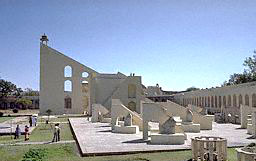
|
"....Shadow clocks are
mentioned in the Bible. The Book of Job refers to
portable gnomos,
probably of the kind that were used in the fields to tell time, when
it observes that the hired laborer "earnestly desireth the shadow"
that indicated it was time to collect his daily wages. Less clear is
the nature of a shadow clock that featured in a miraculous incident
reported in II Kings Chapter 20 and Isaiah Chapter 38. When the
prophet Isaiah told the ailing king Hezekiah that he would fully
recover within three days, the king was disbelieving....
|
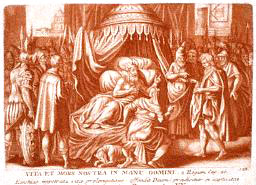
Isaiah visits
King Hezekiah |
"Be it as it may,
scholars by and large agree that the sun clock that served as an
omen for the miraculous recovery of the king was in all probability
a gift presented to the Judean king Ahaz by the Assyrian King Tiglatpiliser II in the eight century B.C.... It was not a Greek
invention nor, it seems, an Egyptian one. According to Plyny the
Elder, the first century savant, the science of gnomonics was first
described by Anaximander of Miletus who possessed an instrument
called "shadow hunter." But Anaximander himself, in his work (in
Greek) Upon Nature (547 B.C.) wrote that he had obtained the gnomon
from Babylon.
"The text in II Kings chapter 20, it seems to us, suggests a sundial
rather than a built staircase and that it was placed in the Temple
courtyard (it had to be in the open where the Sun could cast
shadows). If Andrae was right regarding the astronomical function of
altars, it was possible that the instrument was placed upon the
Templeís main altar. Such altars had four "horns," a
Hebrew term (Keren)
that also meant "corner" as well as "beam, ray" - terms suggesting a
common astronomical origin. Pictorial evidence supporting such a
possibility ranges from early depictions of ziggurats in
Sumer,
where "horns" preceded the circular object all the way to Greek
times. In tablets depicting altars from several centuries after
Hezekiahís time, we can see a viewing ring on a short support placed
between two altars; in a second illustration we can see an altar
flanked by devices for Sun viewing and Moon viewing.
"In considering the astronomical instruments of antiquity, we are in
fact dealing with knowledge and sophistication that go back
millennia to ancient Sumer.
"....If the process of celestial observation progressed from massive
ziggurats and great stone circles to lookout towers and specially
designed altars, the altars with which the astronomer-priests
scanned the heavens at night or tracked the Sun in daytime must have
progressed in tandem. That such instruments became portable thus
makes much more sense, especially if some were used not only for the
original calendrical purposes (fixing festival times) but also for
navigation. By the end of the second millennium B.C. the Phoenicians
of northern Canaan had become the best navigators of the ancient
world; plying the trade routes, one may say, between the stone
pillars of Byblos and the ones in the British Isles, their foremost
western outpost was Carthage (Keret-Hadash, "New City").
Phoenician ruins
at Byblos, center. Sidon, left. Tyre, right
|
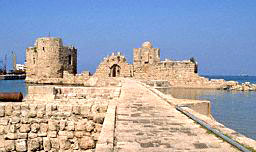 |
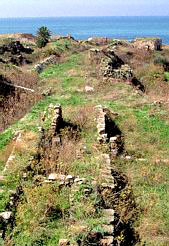 |
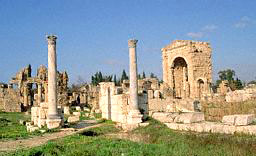 |
|
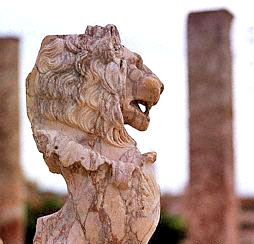 |
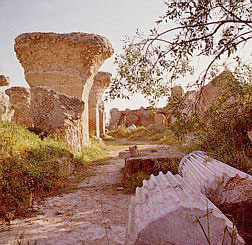
CARTHAGE,
above and left. |
"There they adopted as
their main divine symbol the depiction of an astronomical
instrument; before it began to appear in stelae and even tombstones,
it was shown is association with two double-ringed pillars that
flanked the entrance to a temple - as earlier in Mesopotamia. The
ring flanked by two opposite-facing crescents suggests observations
of the Sun and of the Moonís phases.
Mr. Sitchin gives an ample description of depictions found in the
ruins of a Phoenician settlement in Sicily, and makes a connection
of the symbols there with symbols Egyptians used as well, for
example:
"the Sun rising between two mountains. Indeed, the
Phoenician device
(scholars refer to it as a "cult symbol") suggesting a pair of
raised hands is related to the Egyptian hieroglyph for Ka that
represented the pharaohís spirit or alter ego for the Afterlife
journey to the abode of the gods on the "Planet of millions of
years." That the origin of the Ka was, to begin with, an
astronomical instrument is suggested by an archaic Egyptian
depiction or a viewing device in front of a temple.
"All these similarities and their astronomical origin should add new
insights to understanding Egyptian depictions of the Kaís ascent
toward the godsí planet with outstretched hands that emulate the
Sumerian device, it ascends from atop a pillar equipped with
gradation-steps.... The Egyptian hieroglyph depicting this
step-pillar was called Ded, meaning "Everlastingness."
"....The Egyptian
Book of the Dead has not reached us in the form of
a cohesive book, assuming that a composition that might be called a
"book" truly existed; rather, it has been collated from the
many
quotations that cover the walls of royal tombs. But a complete book
did reach us from ancient Egypt, and it shows that an ascent
heavenward to attain immortality was deemed connected with the
calendar.
"The book we refer to is the
Book of Enoch, an ancient composition
known from two sets of versions, an Ethiopic one that scholars
identify as "1 Enoch," and a Slavonic version that is identified as
"2 Enoch," and which is also known as The Book of the Secrets of
Enoch. Both versions.... are based on early sources that enlarge on
the short biblical mention that Enoch, the seventh Patriarch after
Adam, did not die because, at age 365, "he walked with God" - taken
heavenward to join the deity.
"Enlarging on this brief statement in the
Bible (Genesis chapter 5),
the books describe in detail Enochís two celestial journeys - the
first to learn the heavenly secrets, return, and impart the
knowledge to his sons; and the second to stay put in the heavenly
abode. The various versions indicate wide astronomical knowledge
concerning the motions of the Sun and the Moon, the
solstices and
the equinoxes, the reasons for the shortening and lengthening days,
the structure of the calendar, the solar and lunar years, and the
rule of thumb for intercalation. In essence the secrets that were
imparted to Enoch and by him to his sons to keep, were the knowledge
of astronomy as it related to the calendar.
"Not only the contents of the
Book of Enoch - astronomy as it
relates to the calendar - but also the very life and ascension of
Enoch are thus replete with calendrical aspects. His years on Earth,
365, are of course the number of whole days in a solar year; his
birth and departure from Earth are linked to a specific month, even
the day of the month.... (the sixth day of the month Tsivan, he was
born, and the first day of the month Tsivan was taken away the first
time; the second time he was taken away on the same day and month in
which he was born).
"The Ethiopic version is deemed by scholars to be older by several
centuries than the Slavonic one, and portions of that older version
are in turn known to have been based on even older manuscripts, such
as a lost Book of Noah. Fragments of Enoch books were discovered
among the Dead Sea Scrolls. The astronomical-calendrical tale of
Enoch thus goes back into great antiquity - perhaps, as the Bible
asserts, to pre-Diluvial times.
"Now that it is certain that the
biblical tales of the Deluge and
the Nefilim (the biblical Anunnaki), of the creation of the
Adam and
of Earth itself, and of ante-Diluvial patriarchs, are
abbreviated renderings of original earlier Sumerian texts that recorded all
that, it is almost certain that the biblical "Enoch" was the
equivalent of the Sumerian first priest, EN.ME.DUR.AN.KI ("High
Priest of the MEís of the Bond Heaven-Earth"), the man from the city
Sippar taken heavenward to be taught the secrets of Heaven and
Earth, of divination, and of the calendar. It was with him that the
generations of astronomer-priests, of Keepers of the Secrets, began.
"The granting by Min to the Egyptian astronomer-priests of the
viewing device was not an extraordinary action. A Sumerian sculpture
molded in relief shows a great god granting a hand-held astronomical
device to a king-priest. Numerous other Sumerian depictions show a
king being granted a measuring rod and a rolled measuring cord for
the purpose of assuring the correct astronomical orientation of
temples, as we have seen. Such depictions only enhance the textual
evidence that is explicit about the manner in which the line of
astronomer-priests began.
"Did Man, however, become haughty enough to forget all that, to
start thinking he had attained all that knowledge by himself?
Millennia ago the issue was tackled when Job was asked to admit that
not Man but El, "The Lofty One," was the
Keeper of the Secrets of
Heaven and Earth:
Say, if thow knowest science:
Who hath measured the Earth, that it be known?
Who hath streched a cord upon it?
By what were its platforms wrought?
Who hath cast its Stones of Corners?
"Have you ever ordered
Morning or figured out Dawn according to the
corners of the Earth? Job was asked. Do you know where daylight and
darkness exchange places, or how snow and hailstones come about, or
rains, or dew? "Do you know the celestial laws, or how they regulate
that which is upon the Earth?
"The text and depictions were intended to make clear that the
human
Keepers of the Secrets were pupils, not teachers. The records of
Summer leave no doubt that the teachers, the original Keepers of the
Secrets, were the Anunnaki.
"The leader of the first team of
Anunnaki to come to Earth,
splashing down in the waters of the Persian Gulf, was
E.A - he
"whose home is water." He was the chief scientist of
the Anunnaki
and his initial task was to obtain the gold they needed by
extracting it from the gulfís waters - a task requiring knowledge in
physics, chemistry, metallurgy. As a shift to mining became
necessary and the operation moved to southeastern Africa, his
knowledge of geography, geology, geometry - of all that we call
Earth Sciences - came into play; no wonder his epithet-name changed
to EN.KI, "Lord Earth," for his was the domain of Earthís secrets.
Finally, suggesting and carrying out the genetic engineering
that
brought the Adam into being - a feat in which he was helped by his
half sister Ninharsag, the Chief Medical Officer - he demonstrated
his prowess in the disciplines of Life Sciences: biology, genetics,
evolution. More than one hundred MEís, those enigmatic objects that,
like computer disks, held the knowledge arranged by subject, were
kept by him in his center, Eridu, in Sumer;
and at the Southern tip of
Africa, a scientific station held "the tablet of wisdom."
"All that knowledge was in time shared by Enki with his six sons,
each of whom became expert in one or more of these scientific
secrets.
"Enkiís half brother EN.LIL - "Lord of the Command" -
arrived next
to Earth. Under his leadership the number of Anunnaki
on Earth increased to six hundred; in addition, three hundred
IGI.GI ("Those
who observe and see") remained in Earth orbit, manning orbiting
stations, operating shuttlecraft to an from spacecraft. He was a
great spaceman, organizer, disciplinarian. He established the first
Mission Control Center in NI.IBRU, known to us by its
Akkadian name
Nippur, and the communication links with the Home Planet, the
DUR.AN.KI - "Bond Heaven-Earth." The space charts, the celestial
data, the secrets of astronomy were his to know and keep. He planned
and supervised the setting up of the first space base in Sippar
("Bird City"). Matters of weather, winds and rains, were his
concern; so was the assurance of efficient transportation and
supplies, including the local provision of foodstuffs and the arts
and craft of agriculture and shepherding. He maintained discipline
among the Anunnaki, chaired the council of the "Seven who Judge,"
and remained the supreme god of law and order when Mankind began to
proliferate. He regulated functions of the priesthood, and when
kingship was instituted, it was called by the Sumerians "Enlilship."
"....On his ziggurat, the E.KUR ("House which is like a mountain"),
he had a "beam that searches the heart of all the lands." He "set up
the Duranki," the "Bond Heaven-Earth." In
Nippur a "bellwether of
the universe" he erected. Righteousness and justice he decreed. With
"MEís of heaven" that "none can gaze upon" he established in the
innermost part of the Ekur "a heavenly zenith, as mysterious as the
distant sea," containing the "starry emblems ... carried to
perfection"; these enabled the establishment of rituals and
festivals. It was under Enlilís guidance that "cities were built,
settlements founded, stalls built, sheepfolds erected," riverbanks
controlled for overflowing, canals built, fields and meadows "filled
with rich grain," gardens made to produce fruits, weaving and
entwining taught.
"Those were the aspects of knowledge and
civilization that Enlil
bequeathed to his children and grandchildren, and through them to
Mankind.
"The process by which the Anunnaki imparted such diverse aspects of
science and knowledge to Mankind has been a neglected field of
study. Little has been done to pursue, for example, such a major
issue as how astronomer-priests came into being - an event without
which we, today, would neither know much about our Solar System nor
be able to venture into space. Of the pivotal event, the teaching of
the heavenly secrets to Enmeduranki, we read in a little known
tablet that was fortunately brought to light by W.G. Lambert in his
study Enmeduranki and Related Material.
"....When the instruction of
Enmeduranki in the secret knowledge of
the Anunnaki was accomplished, he was returned to
Sumer. The "men of
Nippur, Sippar and Babylon were called into his presence." He
informed them of his experiences and of the establishment of the
institution of priesthood and that the gods commanded that it should
be passed from father to son....
The episode of Enoch in the Bible attests to this as
Enoch
"....passed this knowledge to
Methuselah. The book of the Secrets of
Enoch includes in the knowledge granted Enoch "all the workings of
heaven, earth and the seas, and all the elements, their passages and
goings and the thunderings of the thunder; and of the Sun and of the
Moon; the goings and changing of the stars; the seasons, years,
days, and hours." This would be in line with the attributes of
Shamash - the god whose celestial counterpart was the Sun and who
commanded the spaceport, and of Adad who was the "weather god" of
antiquity, the god of storms and rains.
"Appeals by later kings to be granted as much "Wisdom" and
scientific knowledge as renowned early sages had possessed, or
boasts that they knew as much, were not uncommon. Royal Assyrian
correspondence hailed a king as "surpassing in knowledge all the
wise men of the Lower World" because he was an offspring of the
"sage Adapa."
A Babylonian king had the same claim.
"....These were references to
Adapa, the sage of Eridu (Enkiís
center in Sumer), whom Enki had taught "wide understanding" of "the
designs of Earth" - the secrets of Earth Sciences.
"....According to the Assyrian references to the
wisdom of Adapa, he
composed a book of sciences titled U.SAR d ANUM d ENLILA - "Writings
regarding Time; from divine Anu and divine Enlil."
Adapa, thus, is
credited with writing Mankindís first book of astronomy and the
calendar.
"When Enmeduranki ascended to heaven to be taught the various
secrets, his patron gods were Utu/Shamash and Adad/Ishkur, a
grandson and son of Enlil. His ascent was thus under Enlilite aegis.
Of Adapa we read that when Enki sent him heavenward to
Anuís abode,
the two gods who acted as his chaperons were Dumuzi and Gizzida, two
sons of Ea/Enki. There, "Adapa from the horizon of heaven to the
zenith of heaven cast a glance; he saw its awesomeness" - words
reflected in the books of Enoch. At the end of the visit
Anu denied
him everlasting life; instead "the priesthood of the city of
Ea to
glorify in future" he decreed for Adapa.
"The implication of these tales is that there were
two lines of
priesthood - one Enlilite and one Enkiíite; and
two central
scientific academies, one in Enlilís Nippur and the other in
Enkiís
Eridu. Both competing and cooperating, no doubt as the two half
brothers were, they appear to have acquired their specialties. This
conclusion, supported by later writings and events, is reflected in
the fact that we find the leading Anunnaki having each their
talents, specialty, and specific assignments.
"....Say, if thow knowest science: Who hath measured the Earth, that
it be known? Who hath stretched a cord upon it?" So was Job asked
when called to admit that God, not Man, was the ultimate Keeper of
the Secrets. In the scene of the introduction of the king-priest to
Shamash, the purpose or essence of the occurrence is indicated by
two Divine Cordholders. The two cords they stretch to a ray-emitting
planet from an angle, suggesting measurement not so much of distance
as of orientation. An Egyptian depiction of a similar motif, a scene
painted on the Papyrus of Queen Nejmet, shows how two cordholders
measure an angled base on the planet called "Red Eye of Horus."
"....Such an orientation was not haphazard or a matter left to
guesswork. The Egyptians relied on divine guidance to determine the
orientation and major axis of their temples, the task was assigned
to Sesheta (Goddess of the Calendar, her symbol was the
stylus made
of a palm branch, which in Egyptian hieroglyphs stood for "counting
the years"... she was the Goddess of Construction (for the purpose
of determining the orientation of temples)).
"....Determining the correct orientation called for an elaborate
ceremony named Put-ser, meaning "the stretching of the cords."
Mr. Sitchin gives more details in his book about the ceremony.
"....The astral aspects of the ceremony have been made clear by
relevant inscriptions, as the one found on the walls of the temple
of Horus in Edfu.
It records the words of the pharaoh:
I take the peg-pole,
I grasp the club by its handle,
I stretch the cord with Sesheta.
I turn my sight to follow the starís movements,
I fix my gaze to the astrality of Msihettu
The star-god that announces the time
reaches the angle of its Merkhet;
I establish the four corners
of the godís temple.
"In another instance concerning the rebuilding of a temple in
Abydos
by the Pharaoh Seti I, the inscription quotes the king thus:
The hammering club in my hand was of gold.
I struck the peg with it.
Thow was with me in thy capacity of Harpedonapt.
Thy hand held the spade during the fixing of
the templeís four corners with accuracy
by the four supports of heaven.
"Sesheta was, according to Egyptian theology, the
female companion
and chief assistant of Thoth, the Egyptian god of sciences,
mathematics, and the calendar - the Divine Scribe, who kept the
godís records, and the Keeper of the Secrets of the construction of
the pyramids.
"As such he was the foremost Divine Architect.
Return
Chapter Six
THE DIVINE
ARCHITECTS
"Some time between 2200 and 2100 B.C. - a time of great import at
Stonehenge - Ninurta, Enlilís Foremost Son, embarked on a major
undertaking: the building of a new "House" for himself at
Lagash.
"The event throws light on many matters of gods and men thanks to
the fact that the king entrusted with the task, Gudea of Lagash,
wrote it all down in great detail on two large clay cylinders. In
spite of the immensity of the task, he realized that it was a great
honor and a unique opportunity to have his name and deeds remembered
for all time, for no many kings were so entrusted; in fact royal
records (since found by archaeologists) spoke of at least one
instance when a famous king (Naram-Sin), otherwise beloved by the
gods, was again and again refused permission to engage in the
building of a new temple (such a situation arose millennia later in
the case of King David in Jerusalem). Shrewdly expressing his
gratitude to his god by inscribing laudatory statements on statues of
himself which Gudea then emplaced in the new temple, Gudea managed
to leave behind a rather substantial amount of written information
which explains the How and What for of the sacred precincts and
temples of the Anunnaki.
"....Throughout the millennia
Ninurta was a faithful aid to his
father (as the Foremost Son of Enlil by his half sister Ninharsag)
carrying out dutifully each task assigned to him.
"....When a brutal war, which in
The Wars of God and Men we have
called the Second Pyramid War, broke out between the
Enlilites and
the Enkiíites, it was again Ninurta who led his fatherís side to
victory. That conflict ended with a peace conference forced on the
warrying clans by Ninharsag, in the aftermath of which the Earth was
divided among the two brothers and their sons and civilization was
granted to Mankind in the "Three Regions" -
Mesopotamia, Egypt and
the Indus Valley.
"The peace that ensued lasted for a long time, but not forever. One
who had been unhappy with the arrangements all along was Marduk, the
Firstborn Son of Enki. Reviving the rivalry between his father and
Enlil which stemmed from the complex succession rules of
the
Anunnaki, Marduk challenged the grant of Sumer and
Akkad (what we
call Mesopotamia) to the offspring of Enlil and claimed the right to
a Mesopotamian city called Bab-Ili (Babylon) - literally, "Gateway
of the Gods." As a result of the ensuing conflicts, Marduk was
sentenced to be buried alive inside the Great Pyramid of Giza; but,
pardoned before it was too late, he was forced to exile; and once
again Ninurta was called upon to help resolve the conflicts.
"Ninurta however was not just a warrior. In the aftermath of the
Deluge it was he who dammed the mountain passes to prevent more
flooding.... he oversaw the introduction of organized
agriculture.... he was assigned to organize Kingship to Mankind at
the first city of Men, Kish....
"....His reward was permission from
Enlil to build a brand new
temple in Lagash. It was not that he was "homeless"; he already had
a temple in Kish, and a temple within the sacred precinct in
Nippur,
next to his fatherís ziggurat. He also had his own temple in the
Girsu, the sacred precinct of his "cult center" the city of
Lagash.
French teams of archaeologists who have been excavating at the site
(now locally called Tello), conducting twenty "campaigns" between
1877 and 1933, uncovered many of the ancient remains of a square
ziggurat and rectangular temples whose corners were precisely
oriented to the cardinal points. They estimate that the foundations
of the earliest temples were laid in Early Dynastic times, before
2700 B.C.... Inscriptions by the earliest rulers of Lagash already
spoke of rebuilding and improvements in the Girsu, as well as of the
presentation of votive artifacts, such as the silver vase by
Entemena, over a period of six or seven hundred years before
Gudeaís
time. Some inscriptions may mean that the foundation for the very
first Eninnu were laid by Mesilim, a king of Kish who had reigned
circa 2850 B.C. Kish, it will be recalled, was where
Ninurta had
established for the Sumerians the institution of Kingship.
|

Naram Sinís
stele of Victory. Although he was the beloved of the
gods, he was not granted permission to build a new
temple. |
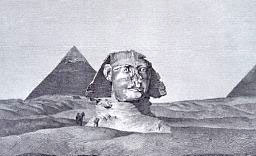
The Second
Pyramid. The site of a great war of the gods. The
aftermath was the division of the Earth in three
Regions. |
|
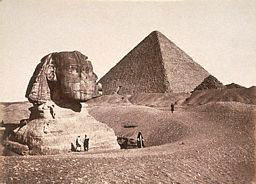
|
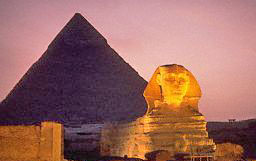
The Great
Pyramid, where Marduk was sentenced to be buried alive.
Pardoned just in time, he was helped out. After another
victory for Enlil from Ninurta, Ninurta entered the
Pyramid for the first time.... |
"....When Ninurta
defeated the Enkiíites he entered the Great Pyramid and for the
first time realized its intricate and amazing inner architecture in
addition to its outer grandeur. The information provided by the
inscriptions of Gudea suggests that Ninurta had nourished a desire
to have a ziggurat of similar greatness and intricacy ever since his
Egyptian tour of duty. Now that he had pacified Sumer and attained
for Lagash the status of a royal capital, he asked
Enlil once again
for permission to build a new E.NINNU, a new "House of Fifty," in
the Girsu precinct of Lagash. This time his wish was to be
fulfilled.
"That his wish was granted should not be downplayed as a matter of
course. We read, for example, in the Canaanite "myths" regarding the
god Baíal ("Lord"), that for his role in defeating the enemies of
El
("The Lofty One," the supreme deity) he sought Elís permission to
build a House on the crest of Mount Zaphon in Lebanon. Baíal had
sought his permission before, and was repeatedly turned down....
"....Now he asked Asherah, Elís spouse, to intercede for him; and
Asherah finally convinced El to give his permission. Added to the
previous arguments was a new one: Baíal she said, could then,
"observe the seasons" in his new House - make there celestial
observations for a calendar.
".... The plans had to be drawn and
construction supervised by the
Kothar-Hasis, the "Skilled and Knowing" Craftsman of the Gods....
The Canaanite texts indeed state that Baíal sent emissaries to
Egypt
to fetch Kothar-Hasis, but found him eventually in Crete.
"No sooner, however, did
Kothar-Hasis arrive than Baíal got into
fierce arguments with him regarding the templeís architecture. He
wanted, it appears, a House of only two parts, not the customary
three - an Hekhal and a Bamtim (a raised stage). The sharpest
argument was over a funnel-like window or skylight which Kothar-Hasis
claimed had to be positioned "in the House" but Baíal vehemently
argued should be located somewhere else....
"....The reasons for the argument regarding the
skylight and its
location remain obscure; our guess is that it might have been
connected with the templeís orientation. The statement by Asherah
that the temple would enable observance of the seasons suggests an
orientation requiring certain astronomical observations. Baíal, on
the other hand, as the Canaanite texts later reveals, was planning
to install in the temple a secret communication device that would
enable him to seize power over other gods. To that purpose Baíal
"stretched a cord, strong and supple," from the peak of
Zaphon
("North") to Kadesh ("the Sacred Place") in the south, in the
Sinai
desert.
"The orientation in the end remained the way the divine architect,
Kothar-Hasis, wanted it.... If, as one must assume, the later
temples atop the Baalbek platform were built according to that olden
plan, then we find that the orientation Kothar-Hasis had insisted
upon resulted in a temple with an east-west axis.
"As the Sumerian tale of the
new Eninnu temple unfolds, we shall see
that it too involved celestial observations to determine its
orientation, and required the services of divine architects.
"The chain of events,
Gudeaís record states, began on a certain day,
a day of great significance. Referring in the inscriptions to
Ninurta by his formal title NIN.GIRSU - "Lord of the Girsu."
"....Recording Ninurtaís complaint about the delay in the building
of the new temple "which is vital to the city in accordance with the
MEís," it reports that on that propitious day
Enlil finally granted
the permission, and he also decreed what the templeís name shall be:
"Its king shall name the temple E.NINNU."
"....Having received the permission of
Enlil and having obtained the
name for the new ziggurat, Ninurta was now free to proceed with the
construction. Without losing time, Gudea rushed to supplicate his
god to be the one chosen for the task.
"....Finally the miracle happened.... He took his asphalt-lined boat
and, sailing on a canal, went to a nearby town to seek an
explanation (about his vision) from the oracle goddess Nanshe in her
"House of Fate-Solving." Offering prayers and sacrifices that she
would solve the riddle of his vision, he proceeded to tell her about
the appearance of the god whose command he was to heed....
"....Having heard the details of the dreamlike vision, the oracle
goddess proceeded to tell Gudea what it meant. The first god to
appear was Ningirsu (Ninurta); "for thee to build his temple,
Eninnu,
he commanded." The heliacal rising, she explained, signaled the god
Ningishzidda, indicating to him the point of the Sun in the horizon.
The goddess (in his vision), was Nisaba; "to build the House in
accordance with the Holy Planet she instructed thee." And the third
god, Nanshe explained, "Nindub, is his name, to thee the plan of the
House he gave."
"Nanshe then added some instructions of her own, reminding
Gudea
that the new Eninnu had to provide appropriate places for Ninurtaís
weapons, for his great aircraft, even for his favorite lyre.
"....Most baffling to him, to begin with, was the matter of the new
templeís orientation....
"....He asked for a second omen; and as he was sleeping
Ningirsu/Ninurta
appeared to him.... The god then lists for Gudea all the inner
requirements of the new temple, expanding at the same time on his
great powers, the awesomeness of his weapons, his memorable deeds
(such as the damming of the waters), and the status he was granted by
Anu, "the fifty names of lordship, by those ordained." The
construction, he tells Gudea, should begin on "the day of the new
Moon," when the god will give him the proper omen - a signal: on the
evening of the New Year the godís hand shall appear holding a flame,
giving off a light "that shall make the night as light as day."
"Ninurta/Ningirsu also assures Gudea that he will receive from the
very beginning of the planning of the new Eninnu divine help: the
god whose epithet was "The Bright Serpent" shall come to
help build
the Eninnu and its precinct - "build it to be like the
House of the
Serpent, as a strong place it shall be built."
"....Losing no time
Gudea proceeded to "purify the city" and
organize the people of Lagash, old and young, to form work brigades
and enlist themselves in the solemn task. In verses that throw light
on the human side of the story, of life and manners and social
problems more than four millennia ago, we read that as a way to
consecrate themselves for the unique undertaking "the whip of the
overseer was prohibited, the mother did not chide her child . . . a
maid who had done a great wrong was not struck by her mistress in
the face." But the people were asked not only to become angelic; to
finance the project, Gudea "levied taxes in the land; as a
submission to the lord Ningirsu the taxes were increased."
"One can stop here for a moment to look ahead to another
construction of a Godís Residence, the one built in the wilderness
of Sinai for Yahweh. The subject is recorded in detail in the
Book
of Exodus, beginning in chapter 25. "Speak unto the Children of
Israel," Yahweh told Moses, "that they may bring for me a
contribution, from every man whose heart shall prompt him thereto
shall be taken an allotment for me... and they shall build for me a
sacred sanctuary, and I shall dwell in their midst. In accordance
with all that which I am showing thee, the plan of the Residence and
the pattern of all the instruments thereof shall ye make it." Then
followed the most detailed architectural instructions - details
which made possible the reconstructions of the Residence and its
components by modern scholars.
"To help Moses carry out these detailed plans,
Yahweh decided to
provide Moses with two assistants whom Yahweh was to endow with a
"divine spirit" - "wisdom and understanding and knowledge of all
manner of workmanship." Two men were chosen by Yahweh to be so
instructed, Bezalel and Aholiab, "to carry out all the sacred work
in all of the manner that Yahweh had ordered." These instructions
began with the layout plan of the Residence and make clear that it
was a rectangular enclosure with its long sides (one hundred cubits)
facing precisely south and north and its short sides (fifty cubits
in length) facing precisely east and west, creating an east-west
axis of orientation.
"By now "greatly wise" and "understanding great things,"
Gudea - to
go back to Sumer some seven centuries before the Exodus - launched
the execution of the divine instructions in a grand way. By canal
and river he sent out boats, "holy ships on which the emblem of
Nanshe was raised," to summon assistance from her followers; he sent
caravans of cattle and asses to the lands of Inanna, with her emblem
of the "star-disk" carried in front; he enlisted the men of
Utu,
"the god whom he loves." As a result, Elamites came from
Elam, Susians came from Susa, Magan (Egypt) and
Melukhah (Nubia) sent a
large tribute from Lebanon, bronze was collected, shiploads of
stones arrived. Copper, gold, silver and marble were obtained.
|
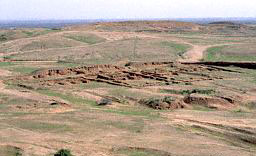
Elamites,
went from Elam to help build the temple for Ninurta.
(Two views from ancient Elam) |
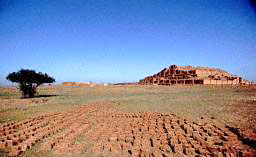
|
|

The Castle
of the French Archaeologists in Susa.
Susians went to help build the temple for Ninurta....
|
|
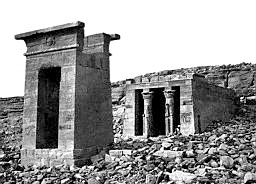 |

From Nubia,
they sent tribute to help build the temple for Ninurta...
Ancient Nubian temple (left), modern above
|
|
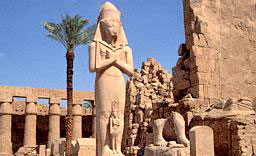
And from
Magan (Egypt) they also sent a great tribute....
|
|
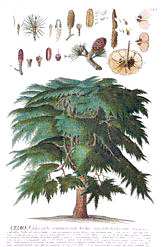 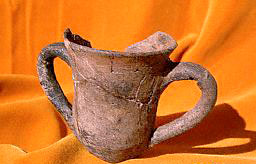 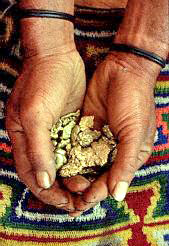
Cedars,
Bronze, Gold was collected.... |
|
 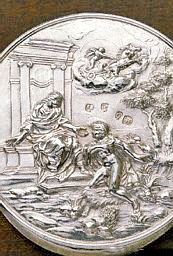
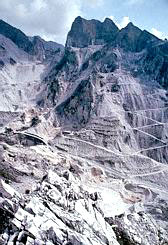
Copper,
Silver and Marble was collected |
"When all that was
ready, it was time to make the bricks of clay. This was no small
undertaking, not only because tens of thousands of bricks were
needed. The bricks - one of the Sumerian "firsts" which, in a land
short of stones, enabled them to build high-rise buildings - were
not of the shape or size that we use nowadays; they were usually
square, a foot or more on each side and two or three inches thick.
They were not identical in all places at all times; they were
sometimes just sun-dried, some times dried in kilns for durability;
they were not always flat, but sometimes concave or convex, as their
function required, to withstand structural stress. As is clear from
Gudeaís as well as other kingsí inscriptions, when it came to
temples, and even more so to ziggurats, it was the god in charge who
determined the size and shape of the bricks; this was such an
important step in the construction, and such an honor for the king
to mold the first brick, that the kings embedded in the wet bricks a
stamped inscription with a votive content. This custom, fortunately,
made it possible for archaeologists to identify so many of the kings
involved in the construction, reconstruction, or repair of the
temples.
"....Ancient, even archaic, Sumerian depictions have been found
dealing with the brick ceremony, one of them shows a seated deity
holding up the Holy Mold, bricks from which are carried to construct
a ziggurat.
"The time has thus come to start building the temple, and the first
step was to mark out its orientation and implant the foundation
stone. Gudea wrote that a new place was chosen for the new Eninnu,
and archaeologists have indeed found its remains on a hill about
fifteen hundred feet away from the earlier one.
"We know from these remains that the ziggurat was built so that its
corners would be oriented to the cardinal points; the precise
orientation was obtained by first determining true east, then
running one or more walls at right angles to each other. This
ceremony too was done on an auspicious day for which "the full year"
had to come to pass. The day was announced by the goddess Nanshe....
"....Apart from depictions of the ceremony, showing a god with the
horned headdress implanting the conical "stone," was actually a
bronze one; the use of the term "stone" is not unusual, since all
metals resulting from quarrying and mining were named with the
prefix NA, meaning "stone" or "that which is mined."
Mr. Sitchin mentions at this point in his book the use of such
"stones" in biblical accounts as well.
"....In Lagash, once the cornerstone was embedded by the god
Ningishzidda, Gudea was able to lay the templeís foundations, by now
"like Nisaba knowing the meaning of numbers."
"The
ziggurat built by Gudea, scholars have concluded, was one of
seven stages. Accordingly, seven blessings were pronounced as soon
as the laying of the foundation stone was completed and the templeís
orientation set and Gudea began to place the bricks along the
marking on the ground:
May the bricks rest peacefully!
May the House by its plan rise high!
May the divine Black Storm Bird be as a young eagle!
May it be like a young lion awesome!
May the House have the brilliance of Heaven!
May joy abound at the prescribed sacrifices!
May Eninnu be a light unto the world!
"Then did Gudea begin to build the "House, a dwelling he established
for his lord Ningirsu . . . a temple truly a Heaven-Earth mountain,
its head reaching heavenward . . ."
"....The king, we read in the inscriptions, "the Righteous
Shepherd," "built the temple bright with metal" bringing copper,
gold, and silver from distant lands. "He built the Eninnu with
stone, he made it bright with jewels; with copper mixed with tin he
held it fast." This is undoubtedly a reference to bronze which, in
addition to its use for various listed artifacts, apparently was
also used to clamp together stone blocks and metals. The making of
bronze, a complex process involving the mixing of copper and
tin
under great heat in specified proportions, was quite an art; and
indeed Gudeaís inscription makes it clear that for the purpose a
Sangu Simug, a "priestly smith," working for the god
Nintud, was
brought over from the "Land of smelting." This priestly smith, the
inscription adds, "worked on the templeís facade; with two
handbreadths of bright stone he faced over the brickwork; with
diorite and one handbreadth of bright stone he . . ." (the
inscription is too damaged here to be legible).
"Not just the mere quantity of stones used in
the Eninnu but the
outright statement that the brickwork was faced with bright stone of
a certain thickness - a statement that until now has not drawn the
attention of scholars - is nothing short of sensational. We know of
no other instance of Sumerian records of temple construction that
mention the facing or "casing" of brickwork with stones. Such
inscriptions speak only of brickwork - its erection, its crumbling,
its replacement - but never of a stone facing over the brick facade.
"Incredibly - but as we shall show, not inexplicably - the facing of
the new Eninnu with bright stones, unique in Sumer, emulated the
Egyptian method of facing step-pyramids with bright stone casings to
give them smooth sides!
"The Egyptian pyramids that were built by
pharaos began with one
built by King Zoser at Sakkara (south of Memphis) circa 2650 B.C.
"Rising in six steps
within a rectangular sacred precinct, it was originally faced with
bright limestone casing stones of which only traces now remain; its
casing stones, as those of ensuing pyramids, were removed by later
rulers to be used in their own monuments.
"The Egyptian pyramids, as we have shown and proved in
The Stairway
to Heaven, began with those built by the Anunnaki themselves - the
Great Pyramid and its two companions at Giza. It was they who
devised the casing with bright stones of what were in their core
step-pyramids, giving them their renowned smooth sides.
"That the new Eninnu in
Lagash, commissioned by Ninurta at about the same time as
Stonehenge
became truly a stone-henge, emulated an Egyptian pyramidís stone
facing, is a major clue for the resolution of the Stonehenge
enigma.
"Such an unexpected link to Egypt, as we have been showing, was only
one among many. Gudea himself was alluding to these connections when
he stated that the shape of the Eninnu and its casing with bright
stones were based on information provided by Nisaba "who was taught
the plan of the temple by Enki" in the "House of Learning." That
academy was undoubtedly in one of Enkiís centers; and Egypt, it will
be recalled, was the domain alloted to Enki and his descendants when
Earth was divided.
"The Eninnu project involved the participation of quite a number of
gods; Nisaba, who had appeared to Gudea in the first vision with the
star map, was not the only female among them.
"....Astronomy clearly played a key role in the
Eninnu project; and
two of the deities involved, Nanshe and Nisaba, were
female
astronomer-gods. They applied their specialized knowledge of
astronomy, mathematics, and metrology not only to temple
construction (as in Gudeaís case), but also in general productive
purposes as well as in ritual roles. One, however, was trained in
the academy of Eridu; the other in that of Nippur.
"Nanshe.... is called in the
Gudea inscriptions "a daughter of Eridu"
(Enkiís city in Sumer). Indeed, in the major Gods Lists of
Mesopotamia, she was called NIN.A - "Lady of Water - and shown as a
daughter of Ea/Enki. The planning of waterways and the locating of
fountainheads were her specialty; her celestial counterpart was the
constellation Scorpio - mul GIR.TAB in Sumerian. The knowledge she
contributed to the building of the Eninnu in Lagash was thus that of
Enkiíite academies.
"A hymn to Nanshe in her role as determiner of the
New Year Day was
her sitting in judgment of Mankind on that day, accompanied by
Nisaba in the role of Divine Accountant who tallies and measures the
sins of those who are judged, such as the sin of he "who substituted
a small weight for a large weight, a small measure for a large
measure." But while the two goddesses were frequently mentioned
together, Nisaba (some scholars read her name Nidaba) was clearly
listed among the Enlilites, and was sometimes identified as a half
sister of Ninurta/Ningirsu. Although she was in later times deemed
to be a goddess who blesses the crops - perhaps because of her
association with the calendar and weather - she was described in
Sumerian literature as one who "opens menís ears," i.e. teaches them
wisdom.... Samuel N. Kramer called her "the Sumerian Goddess of
Wisdom."
"Nisaba was, in the words of D.O. Ezard, the Sumerian goddess of
"the art of writing, mathematics, science, architecture and
astronomy." Gudea specifically described her as the "goddess who
knows numbers" - a female "Einstein" of antiquity . . .
"The emblem of Nisaba was the Holy Sylus.... With her
Holy Stylus Nisaba pointed to Gudea the "favorite star" on the "star tablet"
that she held on her knees; the implication is that the star tablet
had drawn on it more than one star, so that the correct one for the
orientation had to be pointed out from among several stars. This
conclusion is strengthened by the statement in The Blessing of Nisaba
by Enki that Enki had given her as part of her schooling "the
holy tablet of the heavenly stars" - again "stars" in the
plural.
"Her great wisdom and scientific knowledge were expressed in
Sumerian hymns by the statement that she was "perfected with the
fifty great MEís" - those enigmatic "divine formulas" that, like
computer disks, were small enough to be carried by hand though each
contained a vast amount of information.... Nisaba, did not have to
steal the fifty MEís (like Inanna/Ishtar had). A poetic text
compiled from fragments and rendered into English by William H.
Hallo (in a lecture titled "The Cultic Setting of Sumerian Poetry")
that he called The Blessing of Nisaba by Enki, makes clear that in
addition to her Enlilite schooling Nisaba was also a graduate of the
Eridu academy of Enki. Extolling Nisaba as "Chief scribe of heaven,
record-keeper of Enlil, all-knowing sage of the gods" and exalting
Enki "the craftsman of Eridu" and his "House of Learning...."
"The "cult city" of Nisaba was called
Eresh ("Foremost Abode"); its
remains or location was never discovered in Mesopotamia.
Eresh he constructed for her,
in abundance created of pure little bricks.
She is granted wisdom of the highest degree
in the Abzu, great place of Eriduís crown.
"A cousin of Nisaba, the goddess
ERESH.KI.GAL ("Foremost Abode in
the Great Place"), was in charge of a scientific station in southern
Africa and there shared control of a Tablet of Wisdom with
Nergal, a
son of Enki, as a marriage dowry. It is quite possible that it was
there that Nisaba acquired her additional schooling.
"....One of the oddest statements made by
Gudea when he described
the deities who appeared to him concerned Nisaba: "The image of a
temple structure, a ziggurat, she carried on her head." The
headdress of Mesopotamian deities was distinguished by its pairs of
horns; that gods or goddesses would instead wear on their heads the
image of a temple or an object was absolutely unheard of. Yet, in
his inscription, that is how Gudea described Nisaba.
"....Illustration 80 (in
Mr. Sitchinís Book) shows that Nasaba is
indeed carrying on her head the image of a temple-ziggurat.... But
it is not a stepped structure; rather, it is the image of a
smooth-sided pyramid - an Egyptian pyramid!
"Moreover, not only is the
ziggurat Egyptianized - the very custom
of wearing such an image on the head is Egyptian, especially as it
applied to Egyptian goddesses. Foremost of them was Isis, the
sister-wife of Osiris and Nephtys, their sister.
|

Goddess Isis
wearing a headdress exactly as portrayed on Mr.
Sitchinís Book |
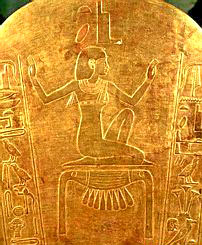
|
"Was Nisaba, an
Enlilite
goddess schooled in Enkiís academy, Egyptianized enough to be
wearing this kind of headdress? As we pursue this investigation,
many similarities between Nisaba and Sesheta, the female assistant
of Thoth in Egypt, come to light.... They included her role as "the
goddess of the arts of writing and of science...." Nisaba possessed
the "stylus of seven numbers"; Sesheta too was associated with the
number seven. One of her epithets was "Sesheta means seven".... Like
Nisaba, who had appeared to Gudea witht he image of a
temple-structure on her head, so was Sesheta depicted with the image
of a twin towered structure on her head, above her identifying
star-and-bow symbol. She was a "daughter of the sky," a chronologer
and chronographer; and like Nisaba, she determined the required
astronomical data for the royal-temple builders.
"According to the
Sumerian texts, the consort of Nisaba was a god
called Haia.... he was the balancer of the scales (in the
judgment
procedures on New Yearís Day). In Egyptian beliefs Judgment Day for
the pharaoh was when he died, at which time his heart was weighed to
determined his fate in the Afterlife. In Egyptian theology, the god
who balanced the scales was Thoth, the god of science, astronomy,
the calendar, and of writing and record keeping.
"Such an overlapping of identities between the deities who provided
the astronomical and calendrical knowledge for the Eninnu reveals an
otherwise unknown state of cooperation between the Sumerian and
Egyptian Divine Architects in Gudeaís time.
"It was, in many respects, an unusual phenomenon; it found
expression in the unique shape and appearance of the Eninnu and in
the establishment within its sacred precinct of an extraordinary
astronomical facility. It all involved and revolved around the
calendar - the gift to mankind by the divine Keepers of the Secrets.
"After the construction of the Eninnu was completed....
"....Now he (Gudea) turned his attention and efforts to
the Girsu,
the sacred precinct as such....
"Cylinder A alone lists more than fifty separate shrines and temples
built adjoining the ziggurat to honor the various gods involved in
the project as well as Anu, Enlil, and Enki.
"....There were also special enclosures or facilities to
house the
Divine Blak Bird, the aircraft of Ninurta, and of his awesome
weapons; as well as places at which the calendrical-astronomical
functions of the new Eninnu were to be performed. There was a
special place for "the Master of Secrets," and the new
Shugalam the
high place of the aperture, the place of determining whose
awesomeness is great, where the Brilliance is announced." And there
were two buildings with the "solving of the cords" and the "binding
with the cords" respectively - facilities whose purpose has eluded
scholars but which had to be connected with celestial observations,
for they were located next to, or were part of, the structures
called "Uppermost Chamber" and "Chamber of the seven zones."
"....There was also a need, as the text makes clear, to await a
certain specific day - New Yearís Day, to be precise - before
Ninurta and his spouse Bau could actually move into the
new Eninnu
and make it their dwelling abode.
"....Cylinder B deals with the rites connected with the consecration
of the new ziggurat and its sacred precinct and the ceremonies
involved in the actual arrival of Ninurta and Bau in the
Girsu -
reaffirming his title as NIN.GIRSU, "Lord of Girsu" - and their
entry into their new dwelling place.
"While the arrival of the inauguration day was awaited - for the
better part of the year - Gudea engaged in daily prayers, the
pouring of libations, and the filling up of the new templeís
granaries with food from the fields and its cattle pens with sheep
from the pastures. Finally the designated day arrived:
The year went round,
the months were completed;
the New Year came in the heavens -
the "Month of the Temple" began.
"On that day, as the "New Moon was born." the dedication ceremonies
began. The gods themselves performed the purification and
consecration rites.
"....The third day, Gudea recorded, was a bright day. It was on that
day that Ninurta stepped out - "with a bright radiance he shone." As
he entered the new sacred precinct, "the goddess Bau was advancing
on his left side." Gudea "sprinkled the ground with an abundance of
oil . . . he brought forth honey, butter, milk, grain, olive oil . .
. dates and grapes he piled up in a heap - food untouched by fire,
food for the eating of the gods."
"The entertainment of the divine couple and the other gods with
fruits and other uncooked foods went on until midday. "When the Sun
rose high over the country" Gudea "slaughtered a fat ox and a fat
sheep" and a feast of roasted meats with much wine began; "white
bread and milk they brought by day and through the night"; and
Ninurta, the warrior of Enlil, taking food and beer for drink, was
satisfied." All the while Gudea "made the whole city kneel, he made
the whole country prostrate itself . . . By day there were
petitions, by night prayers."
"At the morning aurora" - at dawn - "Ningirsu, the warrior, entered
the Temple; into the Temple its lord came; giving a shout like the
cry of battle, Ningirsu advanced into his temple." "It was,"
observed Gudea, "like the rising of the Sun over the land of
Lagash
. . . and the land of Lagash rejoiced." It was also the day in which
the harvest began:
On that day,
when the Righteous God entered,
Gudea, on that day,
began to harvest the fields.
"Following a decree from
Ninurta and the goddess Nanshe, there
followed seven days of repentance and atonement in the land. "For
seven days the maid and her mistress were equal, master and slave
walked side by side . . the rich man did not wrong the orphan, no
man oppressed the widow . . the city restrained wickedness." At the
end of the seven days, on the tenth day of the month, Gudea entered
the new temple and for the first time performed there the rites of
the High Priest, "lighting the fire in the temple-terrace before the
bright heavens."
"A depiction on a cylinder seal from the second millennium B.C.,
found at Ashur, may well have preserved for us the scene that had
taken place a thousand years earlier in Lagash: it shows a
High
priest (who as often as not was also the king, as in the case of
Gudea) lighting a fire on an altar as he faces the godís ziggurat,
while the "favorite planet" is seen in the heavens.
"On the altar, "before the bright heavens, the fire on the
temple-terrace increased." Gudea "oxen and kids sacrificed in
numbers." From a lead bowl he poured a libation. "For the city below
the temple he pleaded." He swore everlasting allegiance to Ningirsu,
"by the bricks of Eninnu he swore, a favorable oath he swore."
"And the god Ninurta, promising Lagash and its people abundance,
that, "the land may bear whatever is good," to Gudea himself said:
"Life shall be prolongued for thee."
"Appropriately, the
Cylinder B inscription concludes thus:
House, rising heavenward as a great mountain,
its luster powerfully falls on the land
As Anu and Enlil the fate of Lagash determine.
Eninnu, for Heaven-Earth constructed,
the lordship of Ningirsu
to all the lands it makes known.
O Ningirsu, thou art honored!
The House of Ningirsu is built;
Glory be unto it!
Return
|

























